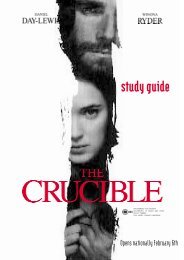Changing values, changing nation - Saint Ignatius' Moodle Community
Changing values, changing nation - Saint Ignatius' Moodle Community
Changing values, changing nation - Saint Ignatius' Moodle Community
Create successful ePaper yourself
Turn your PDF publications into a flip-book with our unique Google optimized e-Paper software.
Resource sheet 5<br />
<strong>Changing</strong> Indigenous rights<br />
Source 1: The impact of the 1965 Freedom Ride<br />
In 1965, some students from Sydney University formed a<br />
group called Student Action for Aborigines (SAFA). Inspired<br />
by the civil rights movement in the United States of<br />
America, particularly the ideas of Reverend Martin Luther<br />
King, they hired an old bus and organised a ‘Freedom<br />
Ride’ around NSW country towns. Their aim was to draw<br />
attention to discrimi<strong>nation</strong> against Aboriginal people. Here<br />
Ann Curthoys, one of the original Freedom Riders, assesses<br />
the effects of the Ride.<br />
In retrospect, it seems that the Freedom Ride, limited<br />
though the students’ understanding of the issues and ideas<br />
about the future may have been, placed the issue of ‘rights’<br />
more firmly on the public agenda than it had been before.<br />
It created a social tension on Aboriginal issues which had<br />
mixed short-term consequences, but which did indeed<br />
make possible the emergence of something new. It insisted<br />
that Aboriginal conditions and demands raise moral and<br />
economic questions which white Australians had, at last,<br />
to face. And it stimulated a new kind of Aboriginal politics,<br />
with far reaching consequences.<br />
Curthoys, Ann 2002, Freedom Ride: A Freedom Rider Remembers, Allen &<br />
Unwin, Crows Nest, NSW, p 239<br />
Source 2: The origins of the Aboriginal flag, 1971<br />
It was a sequence of events which led to me being the<br />
designer of the Aboriginal flag. When I look carefully at<br />
what the Aboriginal flag looks like, it comes from the<br />
simplicity and power of Aboriginal art itself. Simple colour,<br />
choice of colour, and a simple design. It’s powerful, and<br />
the colours are important. And it took some time to think<br />
about it – red ochre, the red soil – the country of Australia<br />
is all red.<br />
Source 3: The 1967 referendum<br />
Most Australian referendums have not been carried<br />
(see http://www.aec.gov.au>When>Referendums><br />
Referendum Dates and Results 1906 – Present). However<br />
in 1967, 90.77 per cent of Australians registered a ‘Yes’<br />
vote to change sections of the Australian Constitution that<br />
discriminated against Indigenous people. All major political<br />
parties supported the proposed changes and both Houses<br />
of Parliament passed the proposed Act unanimously;<br />
consequently a ‘No’ case was not even submitted.<br />
The campaign for a ‘Yes’ vote in the 1967 referendum<br />
suggested that the Aboriginal cause had gained a high<br />
degree of support, for although the changes were quite<br />
mechanical, being simply the granting of a concurrent<br />
power to the Commonwealth to make laws for Indigenous<br />
people, as well as being able to include Indigenous<br />
Australians in <strong>nation</strong>al censuses, most campaigners chose<br />
to talk in terms of morality:<br />
Vote ‘Yes’ for Aborigines, they want to be Australians<br />
too<br />
Vote ‘Yes’ to give them rights and freedoms just like me<br />
and you<br />
Vote ‘Yes’ for Aborigines, all parties say they think you<br />
should<br />
Vote ‘Yes’ and show the world the true Australian<br />
brotherhood.<br />
Sydney Morning Herald, 19 May 1967<br />
Bennett, Scott 1999, White Politics and Black Australians, Allen & Unwin,<br />
Crows Nest, NSW, p 22<br />
Why did I choose the sun? Because it’s another colour<br />
that is used commonly in Aboriginal art – yellow ochre.<br />
But the sun is a great symbol for all people. When we look<br />
carefully at the colour black, which is an interesting one,<br />
it’s more of a political inclusion, rather than a spiritual,<br />
Aboriginal concept. The black represents the pride of<br />
being black in Australia. Because, at the time, black pride<br />
came into Australian culture – during the ’60s and ’70s<br />
– influenced by Black American pride of their culture. If<br />
this is going to be an Aboriginal flag, it has to have black,<br />
because it represents the black people of the continent.<br />
Extract from Dimensions in Time, Ep 7, ‘Harold Thomas - Creator of<br />
the Aboriginal flag’, first broadcast 25 March 2002, is reproduced by<br />
permission of the Australian Broadcasting Corporation, ABC Online<br />
© 2002 ABC. All rights reserved. A full copy of the article can be found at:<br />
http://www.abc.net.au/dimensions/dimensions_in_time/Transcripts/s513731.<br />
htm<br />
Values for Australian Schooling – Teaching and Learning Units ©Commonwealth of Australia<br />
Later adolescence – <strong>Changing</strong> <strong>values</strong>, <strong>changing</strong> <strong>nation</strong><br />
167







